|
|
|
Sort Order |
|
|
|
Items / Page
|
|
|
|
|
|
|
| Srl | Item |
| 1 |
ID:
108952
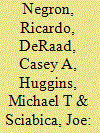

|
|
|
|
|
| Publication |
2011.
|
| Summary/Abstract |
The Air Force Research Laboratory (AFRL) has been helping students to become more literate in science, technology, engineering, and math (STEM), empowering students to become innovators, inventors, self-reliant, and logical thinkers. As technologically proficient problem-solvers, they will be able to compete as skilled "knowledge workers" in the twenty-first century. The laboratory hopes these efforts will help foster development of a future professional workforce prepared in STEM fields that address sensors, power/propulsion/energy, advanced materials/manufacturing, human performance, and air systems. Achieving and sustaining world-class expertise in these technology areas is vitally important to the AFRL's science and technology mission. Its STEM efforts span the whole of its enterprise. The authors report on progress made through specific AFRL STEM-related initiatives in Ohio, New Mexico, and California.
|
|
|
|
|
|
|
|
|
|
|
|
|
|
|
|
| 2 |
ID:
108945
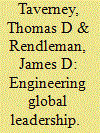

|
|
|
|
|
| Publication |
2011.
|
| Summary/Abstract |
The economic greatness that the United States achieved in the last half of the twentieth century was not assured at the end of World War II. The ascension and U.S. economic juggernaut was secured by three seminal events: (1) the passage of the G.I. Bill; (2) the Soviets' Sputnik launch and the start of the Space Age; and (3) John F. Kennedy's challenge to go to the moon and the subsequent Moon Race. These events spurred the United States to seize and retain leadership in space technology development and space activities; the nation invested in education systems and students, and encouraged a competition that brought out the best from its engineers and scientists and inspired important efforts. The resulting technical genius has fostered advances in a wide variety of other technologies, improving the nation's quality of life. The United States now faces a difficult road ahead unless something is done to reverse recent downward trends in science, technology, engineering, and math education. The authors ask: where is our next G.I. Bill, Sputnik, or Moon Race?
|
|
|
|
|
|
|
|
|
|
|
|
|
|
|
|
| 3 |
ID:
108947
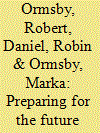

|
|
|
|
|
| Publication |
2011.
|
| Summary/Abstract |
Problems facing the United States and the world today are complex, and the solutions require an innovative workforce, a population with critical thinking and problem solving skills. As the need for people in science, technology, engineering, and math careers continues to grow, the number of students graduating American universities with degrees in these disciplines is decreasing. Reversing this trend requires action at the national (macro-level), and at the classroom (micro-level). For the past three years, Tech Matters has been working with a local university and the kindergarten through 12th-grade school district to address barriers to the integration of science, technology, engineering, and math in the classroom through development and use of computer gaming and simulations. The successful proof of concept of Games for Learning Collaboratory has paved the way for further development.
|
|
|
|
|
|
|
|
|
|
|
|
|
|
|
|
| 4 |
ID:
108948


|
|
|
|
|
| Publication |
2011.
|
| Summary/Abstract |
The Systems Architecting and Engineering Graduate Program at the University of Southern California began as a graduate educational program primarily focused on aerospace and defense. Founded by Eberhardt Rechtin in 1987, the program today is a science, technology, engineering, and math success story in terms of its growth, teaching approach, and contributions to the engineering workforce in aerospace and defense. Systems Architecting and Engineering is a multidisciplinary field that cuts across science, technology, engineering, and math, and draws on concepts from psychology, sociology, biology, and economics. This paper presents the genesis of this program, its teaching philosophy, its evolution in response to the demands of the marketplace, and its vision for the future.
|
|
|
|
|
|
|
|
|
|
|
|
|
|
|
|
| 5 |
ID:
108943
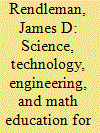

|
|
|
| 6 |
ID:
108946
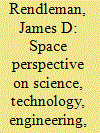

|
|
|
|
|
| Publication |
2011.
|
| Summary/Abstract |
A senior panel of military and civil space, industrial, and academia leaders recently came together under the auspices of the American Institute of Aeronautics and Astronautics to examine the state of science, technology, engineering, and math education within the United States. They concluded that there is a risk to continued U.S. global space leadership without an effective response and educational innovation and funding for technical challenges that are key to that response. This report summarizes the observations made by the panel members.
|
|
|
|
|
|
|
|
|
|
|
|
|
|
|
|
| 7 |
ID:
108950
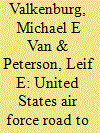

|
|
|
|
|
| Publication |
2011.
|
| Summary/Abstract |
"Bright Horizons" is the United States Air Force's new strategic roadmap for management and development of its military members and civilian employees who are scientists, technologists, engineers, and mathematicians. The roadmap has been approved and signed by the Air Force Chief of Staff and the Secretary of the Air Force and was published in 2011. It has its origins in a 2010 report from the National Research Council titled "Examination of the United States Air Force's Science, Technology, Engineering, and Mathematics (STEM) Workforce Needs in the Future and Its Strategy to Meet Those Needs."
|
|
|
|
|
|
|
|
|
|
|
|
|
|
|
|
| 8 |
ID:
108954
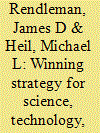

|
|
|
|
|
| Publication |
2011.
|
| Summary/Abstract |
The research, innovation, and engineering triumphs of the United States over the past century are a child of a technologically and scientifically superior workforce. That expertise is at risk, however. Recent challenges to acquiring new space systems are attributable, in significant measure, to the loss of science, technology, engineering, and math (STEM) skills and experience. Evolving space mission needs demand improved STEM skills and experience across the spectrum of the space workforce. Unfortunately, many remedial programs have failed, and economic reality confronts the government, industry, and academic establishments as they are challenged to develop education and professional development programs responsive to STEM needs. To continue its leadership in global space activities, the United States needs to employ a comprehensive strategy to ensure it has a workforce with the skills to achieve short-term and long-term success. It can do this by increasing the numbers, and improving the quality of education and academic development of STEM-educated students, graduates, teachers, professors, and their mentors.
|
|
|
|
|
|
|
|
|
|
|
|
|
|
|
|
|
|
|
|
|